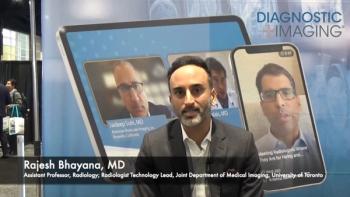
Chest x-rays and abdominal CT aid detection of osteoporosis
Dual x-ray absorptiometry remains the standard-bearer for bone mineral density measurement, but routine chest x-rays and abdominal CT can provide early warning signs of osteoporosis in postmenopausal patients.
Dual x-ray absorptiometry remains the standard-bearer for bone mineral density measurement, but routine chest x-rays and abdominal CT can provide early warning signs of osteoporosis in postmenopausal patients.
Vertebral fractures, for example, are a common complication of osteoporosis, but they often go undetected because they can occur without clinical symptoms. Such fractures may be missed by radiologists on routine lateral chest radiographs.
In a retrospective study of 990 postmenopausal patients vho received a chest x-ray, 131 had osteoporotic-related fractures. Only one-third of these fractures were recorded in the official radiology report, said Dr. Dirk Mueller, a radiologist at the Technical University of Munich, Germany. Of the women in whom fractures were detected, only 21% were referred for appropriate osteoporosis management.
"These fractures lead to health problems, disability, and increased mortality. Because future fractures can be prevented with medication, it's important to recognize them when we see them," Mueller said. "Chest radiographs can serve as a tool to diagnose osteoporosis if radiologists focus on the spine."
The findings are timely, said Dr. Harry K. Genant, an emeritus professor of radiology at the University of California, San Francisco and a pioneer in the development of bone density measurement. He noted that the International Osteoporosis Foundation has launched a campaign to enhance interest in osteoporosis among radiologists.
A second study made a similar case for abdominal CT. Eighty postmenopausal patients at high risk for osteoporosis were evaluated with quantitative CT and subsequently scanned with contrast-enhanced abdominal CT.
A team headed by Dr. Thomas Link, a radiologist at the Technical University of Munich, found a high correlation between BMD values obtained with MSCT and those acquired using standard QCT. The findings are significantly better than those obtained with single-slice CT compared with QCT in a similar study published by Link in Radiology last year (2004;231:805-811).
The best correlations were obtained with a slice thickness of 10 mm and a peeled region of interest. There are limitations to the technique, such as a trend toward lower degrees of contrast enhancement. The important point is that some BMD information can be obtained with routine abdominal CT exams, Link said.
"Since radiologists are losing interest in performing traditional BMD studies, it's important to know that a CT study could provide some information," he said. "We should use screening procedures that are available and feasible in order to get more knowledge about osteoporosis."
Newsletter
Stay at the forefront of radiology with the Diagnostic Imaging newsletter, delivering the latest news, clinical insights, and imaging advancements for today’s radiologists.




























